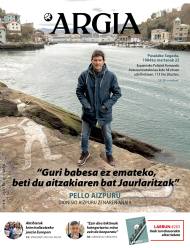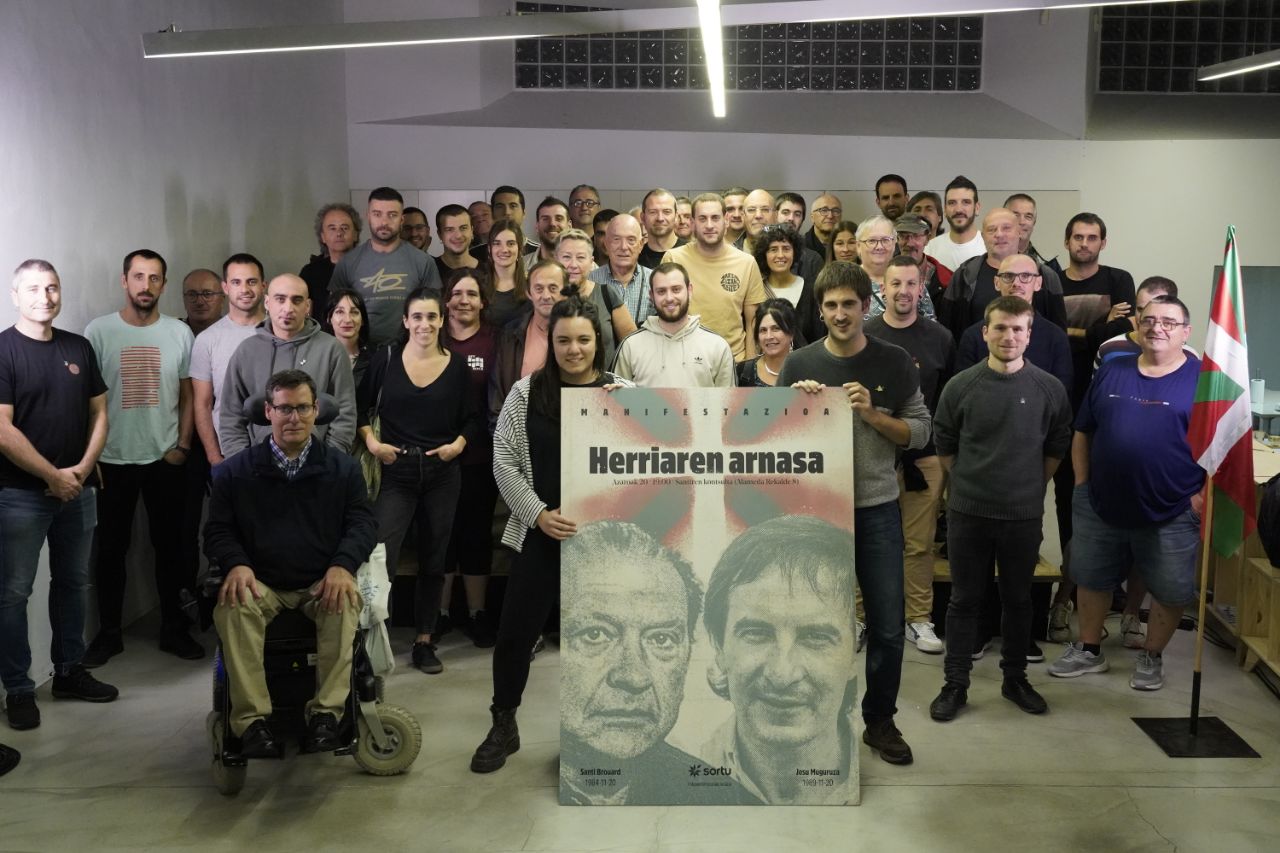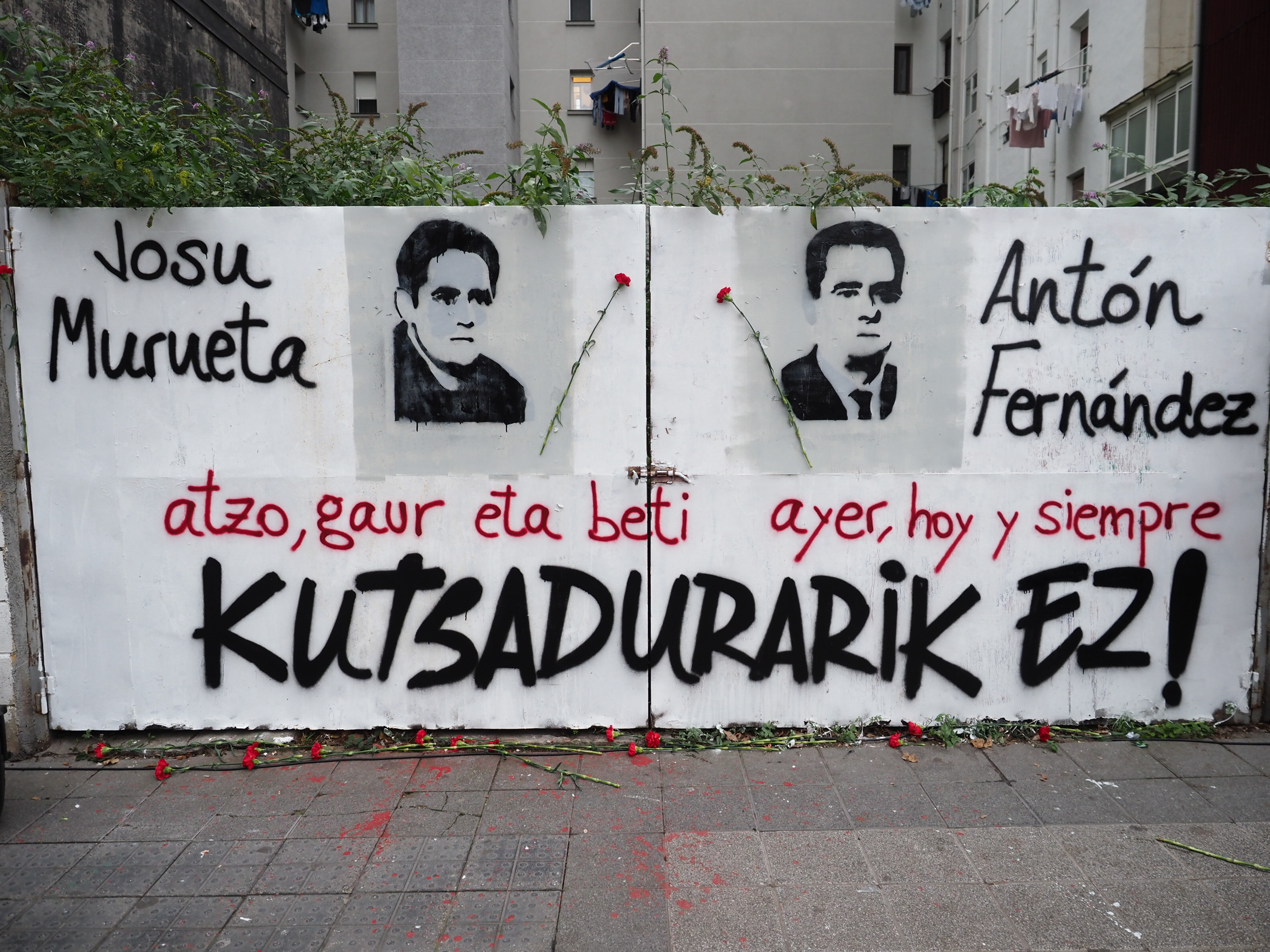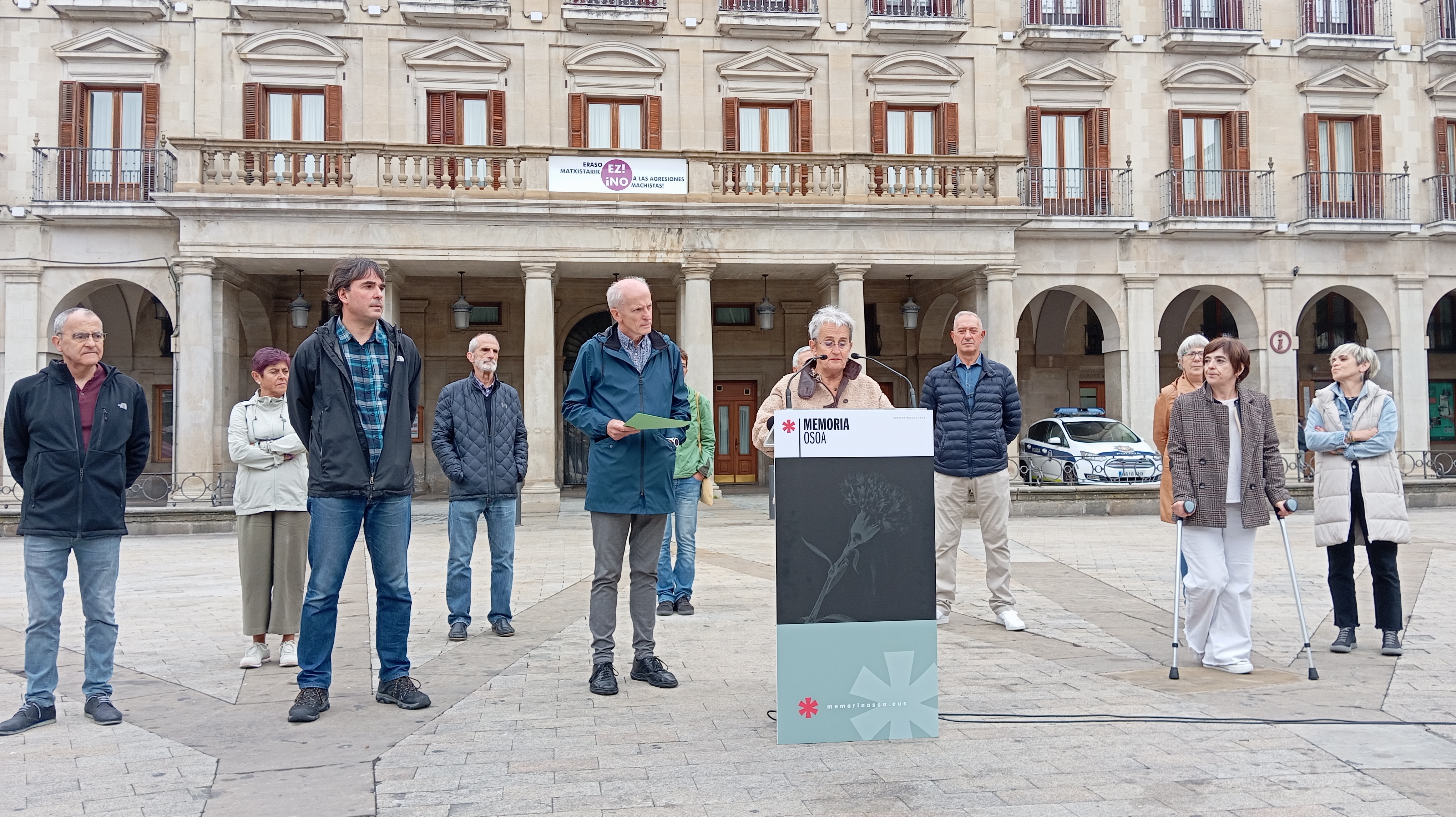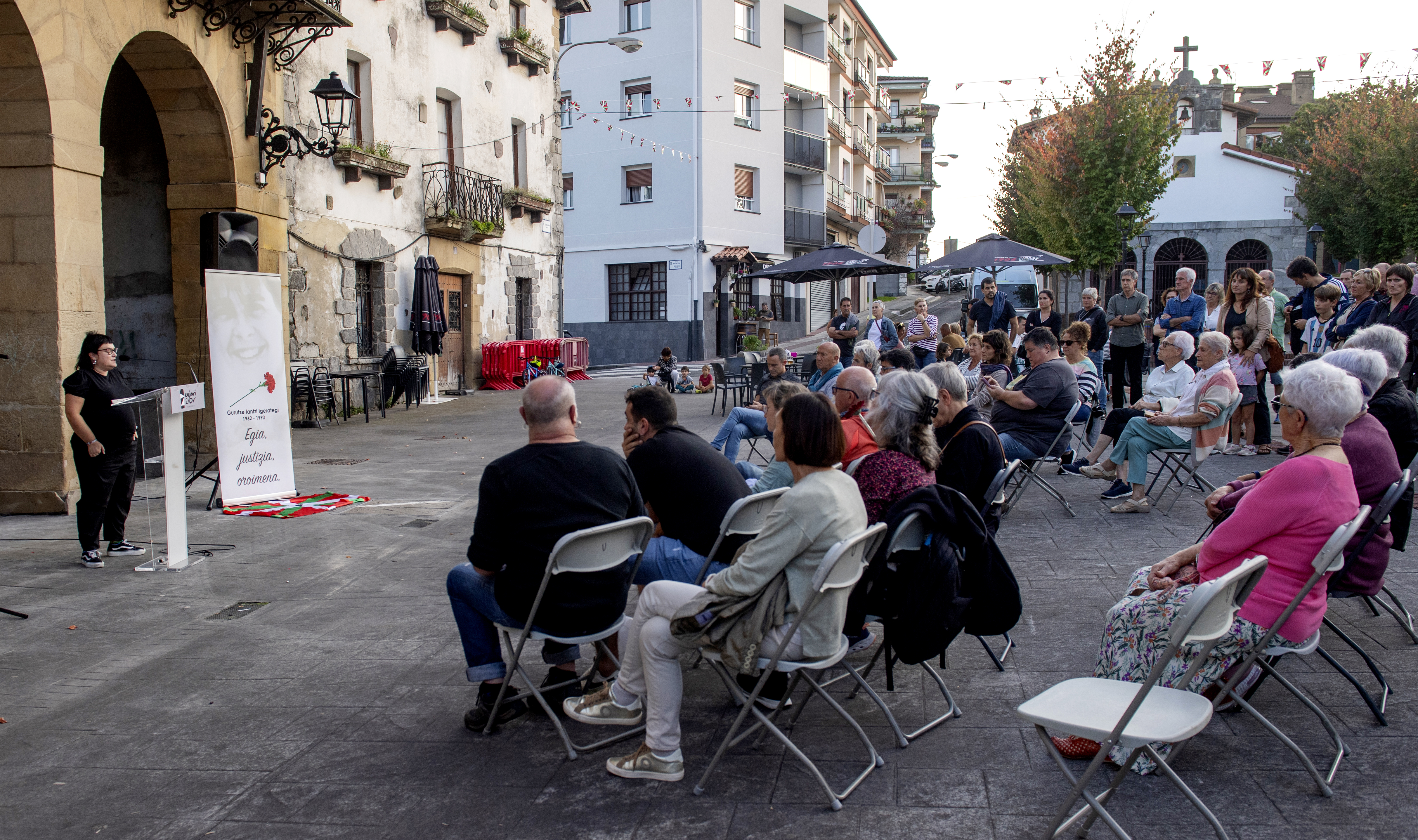Concerning victims, institutions do not act on an equal footing.
- The then Basque Government, president of Carlos Garaikoetxea, did not join the official version. The PNV EBB also disagreed: “Very well prepared trap”. The bishops of San Sebastian and Pamplona also do not: “You cannot put an end to the enemy, because it is an enemy for no more reason.” Juan María Bandrés of the Basque Left said in the Spanish courts to José Barrionuevo, then minister of the Interior: “It has been an empty massacre”… And 40 years, waiting for recognition and reparation. 22 March 1984: Pasaia Bay.

Pello Aizpuru Arbelaitz. Azpeitia, 1963
Since his brother Dionisio was murdered in the bay of Pasaia, the Spanish police, under the supervision of the political leaders of the time, became the guardian of his brother's memory. Since then, the relatives and others of those who killed in that massacre have met more judges than they wanted, have gone through more formalities and advances in these 39 years. And although tiredness or despair has once prevailed, Pello Aizpuru, Arantxi Isart, Jabier Izura, Karlos Delas... have not surrendered, have not surrendered. Knowing the truth, their goal is recognition and reparation.
We're at
Pasaia Donibane in the bay. “Segada, massacre, crime” are three words that express what happened once. We've come here -- a regrettable family success is the reason to come here. The death, the murder, the memory of his brother [Dionisio Aizpuru], the denunciation of the four murders that occurred here. It's 39 years since it happened -- we think the case is clear, pretty clear, we know what happened, but we haven't received recognition. In this sense we have come to this bay of Pasaia.
It reminds anyone who knows the massacre of what happened, as he said. Who doesn't know, what would you say, what happened here? And how do you explain it to those who don't know? It’s not easy… In March 1984 police arrested a woman [Rosa Jimeno]. The word, however, has not
been arrested, but kidnapped. Without news from her daughter, her parents went to the San Sebastian Police Station asking them if Rosa was there and told them no, she was not there. His parents left the police and saw his daughter's car there! They told them to lie. Despite the complaint of her parents, the police did not conduct any investigations. And how would he do it, because Rosa was in his hands at the Amara Police Station in Donostia!
Why did the Spanish police hide Rosa Jimeno, kidnapped? Perhaps because they were already torturing Rosa, preparing the ambush of Pasaia, to touch and give experience to the Autonomous Commands. I have not invented it, we have not told it by the relatives of the dead, the police leaders who were here, or some political leaders said so. And there are the words of
José Bono of the PSOE. Bono, Spanish Defense Minister and President of Congress, reports in one of his books (I will tell you / I will tell you, 2012) that a senior party member – Joaquín Leguina – told him: “[Enrique] when Casasena happened, we joined the PNV, we told them that we had to react, that death in Casas would not stay. And one day, in the evening, when the murdered Houses crossed the Bidasoa, they received reparation.” It literally says so.
What was that compensation? Introduce 113
bullets to four people? 36 to my brother? Seven shots on the back of the neck? How is it possible? First they shot him and then, being on the ground, six consecutive shots? I had another shot in my eye! In total he received 36 shots! How did it happen? How can the police be so cruel why that cruelty? It was barbaric!
.jpg)
"Our Dioni had 36 balazulas. ‘Pelitxo’ 28 and one shot in the back of the neck and one shot in the eye. Pelu, 28 shots and one more in the back.
‘Txapas’, 21”
Rosa Jimeno was kidnapped by the Spanish Police. He was scheduled to get to Pasaia. Four members died, one survivor, Joseba Merino.
Rosa [Jimeno] acted as a lure. He had to make an appointment with which the police had to torture and force. Members came on a zodiac boat from the Northern Basque Country to this bay, and by then they were waiting for hundreds of prepared police officers, there and here. Among them, the GMOs of the Spanish Police [Task Force] came from Guadalajara [Spain]. And so getting them from Guadalajara means they had the time they wanted to completely organize and prepare this operation.
The zodiac reaches the bay… Rosa was tied by the police. He made bright signals to his friends and the zodiac approached the bay. And the usual thing, stop, police! They pulled and pulled off the rope that linked Rosa and then shot. But the shooting succession, the police and the civil guards against those who were on the zodiac. The witness is Joseba Merino, the only survivor of the polling station. He says he was on the zodiac and when they started throwing he jumped into the water. When he tied the storm shot, the police started looking for him and captured him in the water. When she left, Joseba saw our living brother, who was in detention. They had the same thing, Rafael Delas, also out of the water, alive, without wounds. The other two friends [José Mari Izura and Pedro Mari Isart] did not see them, they had to
be killed.
We still have three living friends coming from the zodiac: your brother Dionisio Aizpuru, Rafael Delas and Joseba Merino... The police forced the three to put their hands behind their heads and began to identify one by one. When they identified Joseba Merino they abandoned him and said to our brother and Delas, “Jo and there we will die!” And he took the shotgun and the two were killed nearby. That same night, the autopsy. The on-call coroner was Paco Etxeberria that day, who examined the corpses. According to Etxeberria, Rafa [Delas] received
a firsthand shotgun shot, and said the body had eleven emails, all together. The result of the autopsy matches what Merino says the first shot was a chubasco and then a second shooting to kill our brothers. There are more testimonies, and everyone confirms that there were two shots.
They died in cold blood, although the official version says otherwise. The official version says the police stopped them, the commanders shot him and they answered. The police informed the judge that they had several photographs, proof of this attack and that they would send him
a photo report. That they, the police, were in the pretil at the top of the rocks and that they had photographs of the holes that had been fired by the commanders. But that photographic report never came into the hands of the judge. And even if the judge insisted on asking the police for that test, he never received it. According to Paco Etxeberria, during the autopsy of the corpses, in the cemetery of Polloe [San Sebastian] the police recorded the video autopsy for the first time in his life. Police, by video, grabbing a big camera recording the autopsy! This recording has never appeared either.
.jpg)
.jpg)
What was the case? In the courts, I mean. Despite the testimonies and
results of the autopsy of Paco Etxeberria, three months after the killings, in June, the judge filed the case. I am referring, but I think he said that “a crime has been committed because there is no trace”. Some. Our Dioni had 36 balazulas. Pelitxo [Pedro Mari Isart] 28 and one shot in the back of the neck and one shot in the eye. Pelu [José Mari Izura], 28 shots and one more on the back. Txapas [Rafael Delas], 21; Shotgun shot on the chest and another shot that enters the back of the neck and leaves the front ascending. Paco Etxeberria perfectly defines the ascending direction of this shot. So how will it be possible, knowing the bay, for the cops to shoot up and down and for Txapas to be shot upwards? And with all of them, how can the judge archive the case three months later?
"People who didn't shoot died in cold blood? And despite the shot, they died cold? Did you need 113 bullets to stop four people?”
But they didn't get discouraged. They just needed to archive. Before the year we asked for the case to be reopened. Among others, the statement by
Joseba Merino, whose testimony was not in the previous procedure. And they opened it up, but they didn't keep working. The judges are for that, the prosecutor is for that, but they didn't try. Meanwhile, lawyers also stopped working, and we were left with the justice administration not doing its job, either ahead or back.
What do you think of the official Basque left attitude of the time or the HB? Apparently, there was no good relationship between the self-employed and ETA
members. There were anger and sessions. [The Autonomous Commandos] When Enrique Casas was killed [1984, February 23], a month earlier than Pasaia's, the Abertzale left strongly criticized the Self-Employed and their actions. It was a tough time, some were walking sideways, among others, and we also perceived that lack of protection, that of the official Abertzale left, if you will. Some statements were indeed painful. Only at the village level [Azpeitia], in the town we have had people nearby and the city hall, the mayor was from the PNV and the left Abertzale. Two deaths in Pasaia, Pelitxo and our brother were from the people, and I believe that the people suffered a hard blow, which did not look at him that these two citizens were from one group, or from others.
39 years, and they keep fighting, asking for recognition and reparation… 20 years ago we took Santi
González as a lawyer and he has brought us to this situation. At first we were strong, we believed that we would move forward, that the judges would accept the petitions, but we soon realized that all the new investigations that the judges requested were requested by the police itself. And of course, being the author of those murders the same police officer, he has never collaborated. And how will he collaborate as the culprit! Worse still, it has not cooperated and has hampered our efforts, it has tried to cancel them. In 2004, for example, they tried to prescribe the case, but the San Sebastian Court said no, that it could not be prescribed, that the case had many irregularities. For example, instead of lifting the corpses on the ground, they were raised one kilometer away; the pods did not appear, they could not see any trace of blood… the police erased the remains of blood! This is how the police acted, trying to hide everything. Collaboration?
You have no hope. It is not possible to live in the hope that they will cooperate. That is why we have achieved nothing. We have received the resignations one after the other, it has been a suffering. In one, the police; in the other, ask for more evidence and that the judge did not accept. I don't know how many judges we've met. Some, young people, also beginners, what did they have to do, restart the case of years ago… And so the difficulties have been growing. The road has been hard, hard. In the end, we decided to go along the institutional route, and that is the most painful thing, to become aware of the attitude of the institutions with us: we have on once denounced that there is no police
or judicial will to resolve the case, but that is what we have to say in our institutions. So many coexistence, human rights, life rights and so on, that speech all day long, and not us. Our case, what?
It is not the will of our institutions to fully and absolutely clarify the Pasaia campaign. Our case is very clear. They have all the means, the report of the Basque Government at the time, for example, the one that the judges told him, that those of the command did not shoot. If they didn't shoot, what happened? People who didn't shoot, did they
die in cold blood? And despite the shot, they died cold? Did you need 113 bullets to stop four people? And the rest of the details: knots, from there… That barbarism. There are the testimonies, what do the institutions expect? We don't understand. They always have an excuse. “Because…” in one and “Because…” in the other. They always have some excuse for not supporting us. “Because ...”, always.
.jpg)
On the part of the institutions, from the Basque Government, do the relatives of the deceased here feel helpless? Yes. And we have also decided to denounce it. We have been working for almost 40
years, collecting evidence and other work. And how many hours, how many headache and how much energy… Meanwhile, our parents are dying. In the parents of the four dead, our mother [María Pilar Arbelaitz Peña] is the only survivor. She's going to turn 88! The documentary [La Bahía de Pasaia was projected on the net], in which he was asked about the recognition of our mother and asked how her mother's face was clarified, how would she be grateful for it! His mother says he is going to die and he is going to die without acknowledging the truth. There is no right to that! We are not talking about the 1936 War! The institutions, the government, have everything they need and do not take steps.
You said that you are your mother, the only one who is alive in the parents of the dead... We did not talk about politics, our parents had
no political conscience. It was always “Be careful!”, “Don’t leave!”, heard in many houses. Even when our brother was killed, his father didn't like to participate in tributes. Our father died in 2013 and since then his mother has come to some acts. And although he's lived through hard times, I think he's felt comfortable, he's felt the support of people. And so he participated in the documentary. The rest of the parents were worth it, and our mother also deserves recognition.
Victims on one side, victims on the other. The word seems completely used, almost cursed, manipulated. I, for example, do not consider myself a victim. I'm a relative of a
dead person. Victims, they were killed. I don't like the word victim at all. And look at how they treat some victims and others, and I find it regrettable.
That’s also painful… It’s not going to be! There is
no equality. The memory of this bay has been attacked several times. In one of them, the people here told us that there were civil guards in the village that night. We are aware of the Basque Government, including the Gogoratuz Institute, and in vain, no half word in our favour. The breaking of reminders has taken place on more than one occasion, they are all denounceable, but when they are unilateral, institutional representatives meet there; when it happens to others, we feel that there is no one beside us. As for the victims, the institutions do not act on an equal footing.
"Despite the testimonies and results of Paco Etxeberria's autopsy three months after the killings, in June, the judge filed the case."
Five years ago the case was closed once again. Now, instead, it's open, and the judge will take the police statement back then in San Sebastian -- Even when the case was closed, the judge said that it was a crime against human life, that there were four murders, but they didn't know who the perpetrators were. It was appealed to the Court in Strasbourg
but was not accepted. Then Joseba Merino saw several images on the Internet, and met the cops who participated in Pasaia! We took the images and headed to the court. The judge was new and opened the case and the police that day was in Pasaia Bay called on them to declare themselves charged. And, before declaring, a diligence of recognition will be extended to see whether Rosa Jimeno and Joseba Merino know these cops.
That's hope -- it'll
be very difficult, but so far it's been very difficult, it's difficult every day. The State itself is being investigated, there is always impunity for the State, the difficulties are enormous. The town hall [Azpeitia] collaborates with us, it's a particular indictment, and its lawyer [Aiert Larrarte] says that the first job is done, that we have been recognized that there was crime, but that judges don't know who to accuse the crime, that documentation has been lost. Are they really doing it? Does nobody really know who was involved in that crime? Who gave the orders? Surely someone will know and we ask the institutions for help: we want to know the whole truth and, together with the truth, recognition and reparation.
* * * * * * *
"We have kept at home the newspapers of the time, all that and busy, as well as documents, tests and television images. On one occasion, the young
Yuri Agirre and Xabi Otamendi met in the working group of the relatives of the dead in Pasaia, audiovisual experts, and soon saw that we had enough material to make the documentary. And seeing that the government did not take steps, we decided to collect testimonies, then: Rosa Jimeno, Joseba Merino, then head of the government Carlos Garaikoetxea, forensic Paco Etxeberria, El Drogas de Barricada, author of the song Bahia de Pasaia, Fernando Orgambides of the newspaper El País, relatives… and then we did not interview! That and more. We just lack the will of the government.”
“In the past there were trenches. There were people
on one side, on the other. But I don't know if trenches still persist. I would like to know how many pages the best-selling newspaper in Gipuzkoa has dedicated to Pasaia. What was your attitude, what was the follow-up to the case? Insignificant. Some people don't want to talk about this, they don't care. Others, on the contrary, have acted the other way around, have a different attitude from ours, and Euskal Telebista, in recent times, is offering ample information. This helps us not to forget the case, to get closer to the day, to remember what happened and to explain to the new generations.”
Truths
In the days before 22
March 1984, the Spanish Police arrested Rosa Jimeno, a member of the Autonomous Commandos. Under torture, he forced him to quote himself with his colleagues. The place was Pasaia Bay. Soon, the police prepared an ambush. Hundreds of police officers with special forces GMOs participated. As soon as the zodiac boat of a five-man command reaches the bay, the police shot and killed Pedro Mari Isart and José Mari Izura.
Rafael Delas, Dionisio Aizpuru, lived. From Zodiac, the police sent them to the rocks, where they were killed immediately and in cold blood. The four bodies had 113 shots.
Joseba Merino also lived, jumping into the water. He saw it all. He witnessed. He was also captured. Enrique Casas was charged and convicted of the murder. He served seventeen years in prison. Rosa Jimeno served her three-year sentence.
Police carried the dead bodies of four people one kilometer from the bay. When the bodies were lifted, neither the judge nor the forensic (Paco Etxeberria) were able to collect the usual traces: blood remains, body placement, pods… The autopsy revealed that the police used postas, although they were prohibited, but the judge did not promise ballistic tests.
The judge does not have to identify the police officers who participated in the “operational” order. The judge did not promise to interrogate the police. The judge asked the police for a photo report. He didn't send him. “Disappear... lose.” The judge decides to file the suit in June 1984, three months after the killing. Judge Eduardo Calvo Rojas was later a judge of the Spanish Supreme Court for several years. From there, the relatives of the deceased, detained in their day, friends and friends, neighbors and citizens will travel 40 years...
February 1984
It was the election time for the Basque Parliament. The date was 26 February… By then, as early as January 1983, the PSOE – three months after the Spanish Government’s presidency by Felipe González – had already started the ZEN (Northern Special Zone) plan, without the intervention of the state parliament. The organization of the GAL came from this plan against ETA and the Basque left.
On 16 October 1983, the GAL abolished Lasa and Zabala. On 19 December, in Baiona, the GAL murdered refugee Ramón Oñederra. On December 28, in San Juan de Luz, the GAL attacked Mikel Goikoetxea Txapela. He died three days later. On 8 February 1984 he died in Hendaia Angel Gurmindo Stein and Bixente Perurena Peru. PERD.
On 16 February, in the midst of the election campaign, Iñaki Ojeda was killed by the GMO in the Cruces district of Barakaldo. Juan Manuel Piriz and Juan Manuel González were seriously injured. They also arrested Javier Rubio and Josu Olabarria, who were severely tortured. Then, as in Pasaia Bay, neighbors heard two shooting sequences: Iñaki Ojeda received nineteen shots, seven of them in the heart. Pirit received twelve shots, three González.
On February 23, Enrique Casas was killed by the Autonomous Anti-Capitalist Commands. 22 March, Segada de Pasaia. This was accomplished by the head of the PSE of the time, Ricardo García Danborenea: “For every deceased we will die five months.” Eye. And the impunity of the Spanish State,
which remains until today.
.jpg)
LAST WORD
Remember?
“… the
waters come black in Pasaia
because
the water cannot pass through the
stomach of
Pasaia… the water turns black Pasaia and we keep writing with
its ink… (the waters of Pasaia
cannot pass)
Do you remember who you have next to you right now, remember where we are, where we came from and where we want to go -- do you remember what kind of dawn will the agreement
with the
names
of those who
fell?
(Jose Luis Otamendi, Water not past in Pasaia, section of poems)
2008an Fernando Grande Marlaska epailearen aginduz atxilotu zutenean Ibai Azkonak pairatu zituen torturak aitortu ditu Nafarroako Gobernuak. Euskalerria Irratian, pauso honek suposatzen duena azaldu du Azkonak.









